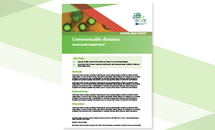Typhoid and paratyphoid fever - Annual Epidemiological Report for 2021
Typhoid and paratyphoid fevers are relatively rare in the European Union/European Economic Area (EU/EEA) and are mainly acquired during travel to countries outside the EU/EEA, particularly southern Asia.
Key facts
- Typhoid and paratyphoid fevers are relatively rare in the European Union/European Economic Area (EU/EEA) and are mainly acquired during travel to countries outside the EU/EEA, particularly southern Asia.
- For 2021, 19 EU/EEA countries reported a total of 304 laboratory-confirmed cases.
- Since the substantial drop in 2020, which was most likely due to the travel restrictions implemented during the COVID-19 pandemic, the number of case reports has remained low. However, in the second half of 2021, an increase in cases was observed, with the usual seasonal peak in September, albeit at a much lower level than the average for 2017−2020.
- Of the 182 cases with available information, 67.9% were travel-related, which was unusually low. A large part of the domestically-acquired cases were infected in the EU outermost regions.
- Multidrug resistance is an increasing problem, more so with S. Typhi than S. Paratyphi. However, vaccination against typhoid fever is available and should be considered by those planning to stay in high-endemicity countries for prolonged periods.
Download

Typhoid and paratyphoid fever - Annual Epidemiological Report for 2021
- EN - [PDF-1.07 MB]







